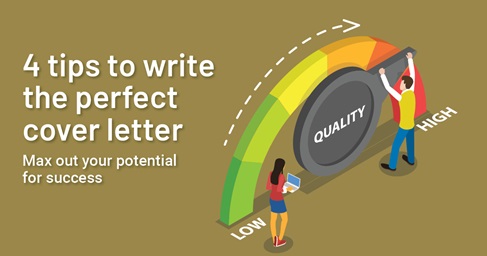
When applying for a job, you will generally be required to submit a cover letter. These can be extremely daunting as not only are they the first point of contact that a candidate has with a prospective employer, but they also have to include responses to the employer's key selection criteria.
Recruiters and HR professionals can receive hundreds of applications for a position and are required to sift through the applications to progress to the next stage in the hiring process.
Your cover letter allows a prospective employer to hear your voice, understand your intentions, determine if you are a suitable fit for the position, and learn a little more about you.
Here are four simple tips to help you make your cover letter stand out.
1. Proofread and fact-check
Your cover letter is your one opportunity to impress a prospective employer. Any spelling or grammatical errors are a big red flag for HR professionals. Always make sure you double check your cover letter, as even the smallest mistake can leave a bad impression and be the reason someone else was successful in securing the role over you. If possible, it’s always great to get a second pair of eyes to proofread your cover letter to pick up on anything you may have missed.
2. Keep it concise and to the point
It’s important when writing your cover letter that you don’t just repeat the contents of your resume. Your cover letter should only reference material from your resume and be used as a space where you can expand on key career highlights or experiences that are relevant to the role. The people involved in the hiring process are usually very busy, so try to be as concise as possible when writing it.
- Bonus Tip: Use bullet points to address key criteria. Bullet points can make it visually easier to read by breaking up large chunks of text. It also makes addressing each key criterion a simpler process. Hiring managers can sift through hundreds of applications, so anything that makes a cover letter more readable (i.e. bullet points) is a huge advantage to the applicant.
3. Customize your cover letter
Make sure that you tailor your cover letter to each application rather than using a template. As each role will most likely have varying key selection criteria, creating a new cover letter for each application will allow you to address each criterion with a fresh perspective and avoid reusing the answers to previous applications. Try to show passion for the organisation and the industry, and make your cover letter relevant to the job description and requirements of the role. This will demonstrate your eagerness for the position.
4. Send your cover letter as a PDF
While most people use Word, not every office computer can open the varying versions. Sometimes sending a Word document to someone who doesn’t have the same version of the program can cause formatting issues. This can make the viewing of your cover letter difficult for the recruiter, or leave them with the impression you have created a poorly formatted document. To avoid formatting errors, save the document as a PDF. This allows you to have more control over how it appears on somebody else’s screen and also prevents the content from being tampered with.
